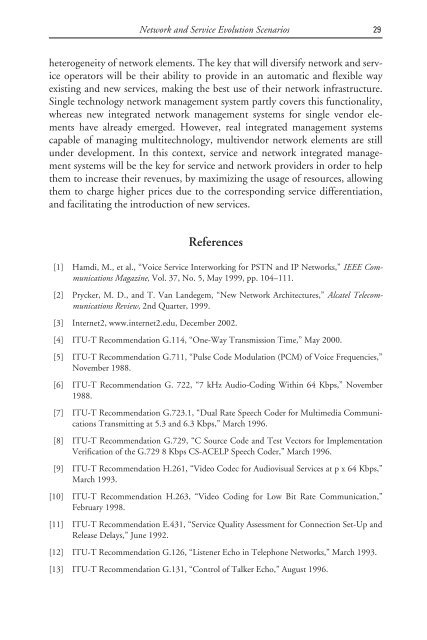deploying and managing ip over wdm networks - Index of
deploying and managing ip over wdm networks - Index of
deploying and managing ip over wdm networks - Index of
Create successful ePaper yourself
Turn your PDF publications into a flip-book with our unique Google optimized e-Paper software.
Network <strong>and</strong> Service Evolution Scenarios 29<br />
heterogeneity <strong>of</strong> network elements. The key that will diversify network <strong>and</strong> service<br />
operators will be their ability to provide in an automatic <strong>and</strong> flexible way<br />
existing <strong>and</strong> new services, making the best use <strong>of</strong> their network infrastructure.<br />
Single technology network management system partly c<strong>over</strong>s this functionality,<br />
whereas new integrated network management systems for single vendor elements<br />
have already emerged. However, real integrated management systems<br />
capable <strong>of</strong> <strong>managing</strong> multitechnology, multivendor network elements are still<br />
under development. In this context, service <strong>and</strong> network integrated management<br />
systems will be the key for service <strong>and</strong> network providers in order to help<br />
them to increase their revenues, by maximizing the usage <strong>of</strong> resources, allowing<br />
them to charge higher prices due to the corresponding service differentiation,<br />
<strong>and</strong> facilitating the introduction <strong>of</strong> new services.<br />
References<br />
[1] Hamdi, M., et al., “Voice Service Interworking for PSTN <strong>and</strong> IP Networks,” IEEE Communications<br />
Magazine, Vol. 37, No. 5, May 1999, pp. 104–111.<br />
[2] Prycker, M. D., <strong>and</strong> T. Van L<strong>and</strong>egem, “New Network Architectures,” Alcatel Telecommunications<br />
Review, 2nd Quarter, 1999.<br />
[3] Internet2, www.internet2.edu, December 2002.<br />
[4] ITU-T Recommendation G.114, “One-Way Transmission Time,” May 2000.<br />
[5] ITU-T Recommendation G.711, “Pulse Code Modulation (PCM) <strong>of</strong> Voice Frequencies,”<br />
November 1988.<br />
[6] ITU-T Recommendation G. 722, “7 kHz Audio-Coding Within 64 Kbps,” November<br />
1988.<br />
[7] ITU-T Recommendation G.723.1, “Dual Rate Speech Coder for Multimedia Communications<br />
Transmitting at 5.3 <strong>and</strong> 6.3 Kbps,” March 1996.<br />
[8] ITU-T Recommendation G.729, “C Source Code <strong>and</strong> Test Vectors for Implementation<br />
Verification <strong>of</strong> the G.729 8 Kbps CS-ACELP Speech Coder,” March 1996.<br />
[9] ITU-T Recommendation H.261, “Video Codec for Audiovisual Services at px64Kbps,”<br />
March 1993.<br />
[10] ITU-T Recommendation H.263, “Video Coding for Low Bit Rate Communication,”<br />
February 1998.<br />
[11] ITU-T Recommendation E.431, “Service Quality Assessment for Connection Set-Up <strong>and</strong><br />
Release Delays,” June 1992.<br />
[12] ITU-T Recommendation G.126, “Listener Echo in Telephone Networks,” March 1993.<br />
[13] ITU-T Recommendation G.131, “Control <strong>of</strong> Talker Echo,” August 1996.


